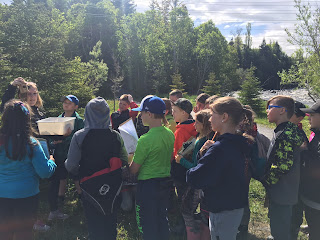This is a guest post from DUC summer student Sarah Wilkins.
When a community takes the step to sign a municipal habitat stewardship agreement, it ensures that the next generation will have a healthy environment to enjoy, whether it be a walking trail, a fishing hole, a favourite berry picking spot, a community garden, or an outdoor classroom.
When a community takes the step to sign a municipal habitat stewardship agreement, it ensures that the next generation will have a healthy environment to enjoy, whether it be a walking trail, a fishing hole, a favourite berry picking spot, a community garden, or an outdoor classroom.
Having
green spaces where children can learn and play is vital to their development
and overall health. Kids who play outdoors are more physically active, more
creative, less aggressive, show better concentration, and are more likely to be environmentally conscious adults. The National Wildlife Federation states that the most direct route to caring for the environment as an adult is participating in “wild nature activities” before the age of 11. Combining the
outdoors with education for students is the number one mission of Project
Webfoot.
In
the last month, I have had the pleasure of meeting children across the province
by delivering Project Webfoot field trips everywhere from St. Mary’s on the Avalon peninsula to Corner
Brook on the west coast of the island. Project Webfoot is Ducks Unlimited Canada’s elementary school program
which links specifically to the grade 4 curriculum. Field trips and in-class resources focus on the value of wetland habitat for both wildlife and people.
In June 2017, Project
Webfoot field trips were delivered by DUC staff to grade 4 students from four SAM member municipalities: Flower's Cove, Hawke's Bay, Deer Lake and Springdale. In addition, partner organizations delivered the program in Happy Valley - Goose Bay (for the first year ever, thanks to Healthy Waters Labrador!), Grand Falls - Windsor (delivered by Corduroy Brook Enhancement Association), St. John's (delivered at the Fluvarium) and Indian Bay (delivered by staff at the Indian Bay Ecosystem Corporation). The field trip program incorporates outdoor learning by
showing kids how to use binoculars and a spotting scope, how to identify male
and female birds, as well as finding and identifying the aquatic invertebrates
that many birds call their lunch! Games are geared to teach
children what a wetland is, how to differentiate the several types of wetlands
in Newfoundland and Labrador, and the many values wetlands offer people, wildlife, and the
environment.
 |
| Explaining a game in Corner Brook. |
If you are interested in a wetland-themed
presentation for a summer camp or a Girl Guide/Scout group in your area or have any
other questions about Project Webfoot and Ducks Unlimited Canada, please contact Danielle, Emma or Sarah at the DUC office in St. John's at du_newfoundland@ducks.ca or 709-237-DUCK (3825).
 |
| Corner Brook Marsh. |



No comments:
Post a Comment